Panel 1
Camilla Antonini, Saša Raicevich
During the period considered (2007-2022), the average exploitation rate of fish stocks (i.e., the mean ratio between current fishing mortality and the mortality associated with the Maximum Sustainable Yield; Fcurr/FMSY) exceeded the sustainability threshold. The indicator, estimated on internationally validated analytical stock assessments, highlights the overall trend in the exploitation rate of commercially fished stocks, providing insight into the quantitative trends in fishing pressure.
A peak in the average exploitation rate was observed in 2012 and 2013, with values exceeding 3, followed by a declining trend, reaching its lowest point in 2022 (average value of 1.12). The analysis is conducted at the National level and by Sub-Region, following the geographical scale defined by the Marine Strategy Framework Directive (MSFD; 2008/56/EC).
The indicator represents the trend of the average ratio of current fishing rate/mortality (Fcurr) to Maximum Sustainable Yield (FMSY or its proxies, F0.1, EMSY=0.4, among others) for National fish stocks. This parameter is estimated using a modeling approach based on established procedures, including biological and catch data of the species.
Only Fish stocks assessed using analytical stock assessment procedures, whose results have been internationally validated by EU technical Commission (STECF - Scientific, Technical and Economic Committee for Fisheries) and the General Fisheries Commission for the Mediterranean (GFCM) are considered for the estimation of the indicator.
Since stock assessments generally refer to years prior to the assessment year, the stock status is conventionally referred to the year preceding the consolidation of the international evaluation.
A National-level assessment is provided, covering all seven Geographical Subareas (GSA) defined as management areas by the FAO-GFCM, which include Italian waters: GSA 9, 10, 11, 16, 17, 18, and 19. Estimates are also given from small pelagic fish, demersal fish and crustaceans.
Some of the fish stocks considered are shared by multiple countries (EU member or not). The pool of assessed stocks varies annually. This indicator is also correlated with the annual EU landings of the assessed stocks, providing useful insights into the interpretation of the available information and the existing knowledge gaps at the National level.
To demonstrate the overall trend in the exploitation rate of commercially fished stocks in relation to sustainability targets.
Both at the international and EU levels, there are specific sustainability objectives for fisheries. Progress toward these goals can be tracked using the exploitation rate indicator, which serves as a proxy to represent the sustainability of resource extraction. Below are the key regulatory references and main objectives at the international level:
European Marine Strategy Framework Directive (MSFD) – Directive 2008/56/EC establishes a framework for EU-wide marine environmental policy (Official Journal of the European Union L 164, 25.06.2008).
According to this Directive and its methodological standards (Commission Decision (EU) 2017/848 of 17 May 2017), within Descriptor 3 (Commercial fish and shellfish), the following sustainability criteria are applied:
- Criterion D3C1 — Primary: The fishing mortality rate of populations of commercially-exploited species is at or below levels which can produce the maximum sustainable yield (MSY).
- Criterion D3C2 — Primary: The Spawning Stock Biomass of populations of commercially-exploited species are above biomass levels capable of producing maximum sustainable yield.
EU Common Fisheries Policy (CFP) – Regulation (EU) 1380/2013
- Defines the EU's Common Fisheries Policy (CFP) (Official Journal of the European Union L 354, 28.12.2013).
- Article 2 (Objectives), Paragraph 2 states:
- " The CFP shall apply the precautionary approach to fisheries management, and shall aim to ensure that exploitation of living marine biological resources restores and maintains populations of harvested species above levels which can produce the maximum sustainable yield."
- " In order to reach the objective of progressively restoring and maintaining populations of fish stocks above biomass levels capable of producing maximum sustainable yield, the maximum sustainable yield exploitation rate shall be achieved by 2015 where possible and, on a progressive, incremental basis at the latest by 2020 for all stocks."
Aichi Biodiversity Target 6 (CBD)
- By 2020, all fish and invertebrate stocks and aquatic plants are managed and harvested sustainably, legally and applying ecosystem-based approaches.
- Overfishing is avoided, recovery plans and measures are in place for all depleted species.
- Fisheries have no significant adverse impacts on threatened species and vulnerable ecosystems.
- The impacts of fishing on stocks, species and ecosystems are within safe ecological limits.
UN Sustainable Development Goal (SDG) 14.4
- By 2020, effectively regulate harvesting and end overfishing, illegal, unreported and unregulated fishing and destructive fishing practices.
- Implement science-based management plans, in order to restore fish stocks in the shortest time feasible, at least to levels that can produce maximum sustainable yield as determined by their biological characteristics..
- Associated Indicator: “Proportion of fish stocks within biologically sustainable levels”, measuring the sustainability of global fish catches relative to their abundance.
- A stock with an abundance above or at the level capable of producing MSY is classified as biologically sustainable. (http://www.fao.org/sustainable-development-goals/indicators/14.4.1/en/).
Panel 2
Scientific, Technical and Economic Committee for Fisheries (STECF) – 2017 Mediterranean Stock Assessments - Part I (STECF-17-15). Publications Office of the European Union, Luxembourg, 2017, ISBN 978-92-79-67487-7, doi:10.2760/897559, JRC109350
Scientific, Technical and Economic Committee for Fisheries (STECF) - 2017 Mediterranean Stock Assessments - Part 2 (STECF-17-15); Publications Office of the European Union, Luxembourg, ISBN 978-92-79-67494-5, doi:10.2760/90316, JRC111820
Scientific, Technical and Economic Committee for Fisheries (STECF) – 56th Plenary Meeting Report (PLEN-17-03); Publications Office of the European Union, Luxembourg; ISBN 978-92-79-77297-9, doi:10.2760/605712, JRC109344
Scientific, Technical and Economic Committee for Fisheries (STECF) – 57th Plenary Meeting Report (PLEN-18-01), Publications Office of the European Union, Luxembourg, 2018, ISBN 978-92-79-85804-8, doi:10.2760/088784, JRC111800
Scientific, Technical and Economic Committee for Fisheries (STECF) – 2018 Mediterranean Stock Assessments - Part 1 (STECF-18-12). Publications Office of the European Union, Luxembourg, 2018, ISBN 978-92-79-79395-0, doi:10.2760/838965, JRC114779
Scientific, Technical and Economic Committee for Fisheries (STECF) – 2018 Mediterranean Stock Assessments - Part 2 (STECF-18-16). Publications Office of the European Union, Luxembourg, 2018, ISBN 978-92-79-79399-8, doi:10.2760/598716, JRC114787
Scientific, Technical and Economic Committee for Fisheries (STECF) – Stock Assessments: demersal stocks in the western Mediterranean Sea (STECF-19-10). Publications Office of the European Union, Luxembourg, 2019, ISBN 978-92-76-11288-4, doi:10.2760/5399, JRC119055
Scientific, Technical and Economic Committee for Fisheries (STECF) – 2019 Stock Assessments part 2: European fisheries for demersal species in the Adriatic Sea (STECF-19- 16). Publications Office of the European Union, Luxembourg, 2019, ISBN 978-92-76-14558-5, doi:10.2760/95875, JRC119057
Scientific, Technical and Economic Committee for Fisheries (STECF) – Stock Assessments: demersal stocks in the western Mediterranean Sea (STECF-20-09). EUR 28359 EN, Publications Office of the European Union, Luxembourg, 2020, ISBN 978-92-76-27165-9, doi:10.2760/286667, JRC122993
Scientific, Technical and Economic Committee for Fisheries (STECF) – Stock Assessments in the Mediterranean Sea - Adriatic, Ionian and Aegean Seas (STECF-20-15). EUR 28359 EN, Publications Office of the European Union, Luxembourg, 2020, ISBN 978-92-76-27168-0, doi:10.2760/877405, JRC122994 FAO. 2020.
The State of Mediterranean and Black Sea Fisheries 2020. General Fisheries Commission for the Mediterranean. Rome. https://doi.org/10.4060/cb2429en Scientific, Technical and Economic Committee for Fisheries (STECF) – Stock assessments in the Mediterranean Sea 2021 – Adriatic and Ionian Seas (STECF-21-15). EUR 28359 EN, Publications Office of the European Union, Luxembourg, 2021, ISBN 978-92-76-46195-1, doi:10.2760/59806, JRC127766.
Scientific, Technical and Economic Committee for Fisheries (STECF) – Stock Assessments: demersal stocks in the western Mediterranean Sea (STECF-21-11). Publications Office of the European Union, Luxembourg, 2021, EUR 28359 EN, ISBN 978-92-76-46116-6, doi:10.2760/046729, JRC127744
Scientific, Technical and Economic Committee for Fisheries (STECF) – Methods for supporting stock assessment in the Mediterranean (STECF-21-02). Publications Office of the European Union, Luxembourg, 2021, EUR 28359 EN, ISBN 978-92-76-40594-8, doi:10.2760/457201, JRC126125. Technical and Economic Committee for Fisheries (STECF) Quality checking of MED & BS data and reference points (STECF-22-03). Publications Office of the European Union, Luxembourg, 2023, doi:10.2760/465703, JRC130288.
Scientific, Technical and Economic Committee for Fisheries (STECF) – Stock Assessments: demersal stocks in Adriatic, Ionian and Aegean Seas and straits of Sicily (STECF-22-16). Publications Office of the European Union, Luxembourg, 2023, doi:10.2760/25344, JRC132157.
Scientific, Technical and Economic Committee for Fisheries (STECF) – Stock Assessments: demersal stocks in Adriatic, Ionian and Aegean Seas and straits of Sicily (STECF-22-16). Publications Office of the European Union, Luxembourg, 2023, doi:10.2760/25344, JRC132157.
Scientific, Technical and Economic Committee for Fisheries (STECF) - Stock assessments in the Western Mediterranean Sea (STECF 23-09), Mannini, A., Ligas, A. and Pierucci, A. editor(s), Publications Office of the European Union, Luxembourg, 2023, doi:10.2760/995295, JRC135661.
Scientific, Technical and Economic Committee for Fisheries (STECF) - Stock Assessments in the Adriatic, Ionian and Aegean Seas and Strait of Sicily (STECF-23-12), Publications Office of the European Union, Luxembourg, 2023.
Scientific, Technical and Economic Committee for Fisheries (STECF) - Methodologies for Mediterranean stock assessments and the estimation of reference points (STECF- 24-02), Publications Office of the European Union, Luxembourg, 2024.
General Fisheries Commission for the Mediterranean (GFCM) - Report of Seventh Meeting of the Subregional Committee for the Western Mediterranean (SRC-WM), Rome, Italy, 21–24 May 2024. p. 116.
General Fisheries Commission for the Mediterranean (GFCM) - Report of Seventh Meeting of the Subregional Committee for the Adriatic Sea (SRC-AS), Podgorica, Montenegro, 28–31 May 2024. p. 131.
The indicator is influenced by the number and type of stocks assessed. Taken together, the available assessments allow for an average representation of stocks associated with less than 50 percent of the national landings.
In order to make the indicator more comparable in temporal and spatial terms, the path of implementing fish stock assessment by stock assessment on a stable set of fish stocks should be consolidated, as moreover envisaged in the GFCM by the Data Collection Reference Framework (DCRF). As such, it is necessary for the analytical effort to consider fish stocks to an extent that can track the pressure and status of a greater percentage of national landings. Also at the Mediterranean level, it is considered appropriate to establish a coordinated approach with respect to the selection of reference points and methodological approaches for their estimation. as well as to define the uncertainty associated with the estimation of reference points.
Data quality assessment
EUROSTAT (Statistical Office of the European Communities)
GFCM (General Fisheries Commission for the Mediterranean)
STECF (Scientific, Technical and Economic Committee for Fisheries)
Internationally validated stock assessment data from STECF and GFCM (annual reports): https://stecf.jrc.ec.europa.eu/reports
http://www.fao.org/gfcm/activities/fisheries/stock-assessment/en/
Fish species landings data from STECF and EUROSTAT through the EUMOFA platform (annual reports):
https://stecf.jrc.ec.europa.eu/dd/fleet https://www.eumofa.eu/
National
2007-2022
Indicator assessment
The status of stocks assessed by STECF and/or GFCM were considered for each year. The stock status is assessed by the ratio of current fishing rate/mortality (Fcurr) to reference point (FMSY) consistent with achieving Maximum Sustainable Yield (MSY).
For FMSY, the proxy value F0.1, obtained through Yield per Recruit analysis, is generally used. Stocks are classified in overexploitation if Fcurr > F0.1: a stock is defined as “overexploited” if it is caught faster than the maximum sustainable yield.
This methodological approach aligns with the GFCM's Mediterranean-scale assessment presented in the biennial report "The State of Mediterranean and Black Sea Fisheries 2020" (GFCM, 2020), allowing direct comparisons between National and Regional estimates.
For small pelagic stocks (such as sardines and anchovies), if direct F estimates are unavailable, the exploitation rate (E = F/Z) is considered. The effort EMSY, the one that provides the Maximum Sustainable Yield (MSY), is set at 0.4, as suggested by Patterson (1992), unless alternative limits are justified in the technical assessment documentation. Stocks with E > EMSY are classified as overexploited.
For some stocks, the assessment is conducted in multiple GSA (FAO Geographical Sub-Areas), sometimes including GSAs from third countries or multiple national subregions.
The analysis does not include large pelagic stocks (such as bluefin tuna and swordfish), as these species are assessed at an international level by ICCAT (International Commission for the Conservation of Atlantic Tunas) over broad geographic scales (Atlantic-Mediterranean and Mediterranean, respectively).
In 2022, the 29 assessed fish stocks recorded an average exploitation rate of 1.12, indicating unsustainable exploitation, even if the value is close to the reference value (= 1). Moreover, the highest percentage of national landings covered by stock assessment evaluations was observed in the last two years (64.2% in 2021 and 62.0% in 2022), indicating an improvement in the knowledge base.
While this result is encouraging—particularly within the highly multi-species nature of national and Mediterranean fisheries—it underscores the need to further increase the number of stocks assessed through stock assessment, especially those stocks with greater weight significance in national landings.
In the period 2007-2022 the average exploitation rate has consistently been unsustainable. After peaking in 2012 and 2013 (values exceeding 3), a gradual decline followed, reaching a minimum value in 2022 (average of 1.12), likely associated with the effects of the COVID-19 pandemic on fishing activities and the implementation of stricter regulations. However, future trends will need to be monitored.
Data
ISPRA processing of stock assessment data validated internationally by STECF and GFCM
*In the case of stocks of small pelagics (sardines and anchovies), the exploitation rate (E = F/Z) is considered. The reference limit (EMSY) for defining whether a stock is overfished is set at 0.4, as suggested by Patterson (1992). In the case where E>EMSY the stocks.
update to december 2023
Figure 3: Average annual value (of F/Fmsy ratio expressed by functional group and GSA in relation to landings per GSA (base year 2018)
ISPRA processing of stock assessment data validated internationally by STECF and GFCM
*In the case of stocks of small pelagics (sardines and anchovies), the exploitation rate (E = F/Z) is considered. The reference limit (EMSY) for defining whether a stock is overfished is set at 0.4, as suggested by Patterson (1992). In the case where E>EMSY the stocks are then classified as being in an overfished state.
update to december 2023
Figure 4: Representation of landings from the EU fishing fleet for major fish species and representation of F/Fmsy ratio (reference year 2018)
ISPRA processing of stock assessment data validated internationally by STECF and GFCM
PIL: Sardina pilchardus, ANE: Engraulis encrasicolus, MUT: Mullus barbatus, DPS: Parapenaeus longirostris, SOL: Solea solea, HKE: Merluccius merluccius, MTS: Squilla mantis, ARS: Aristaeomorpha foliacea, NEP: Nephrops norvegicus, ARA: Aristeus antennatus.
update to december 2023
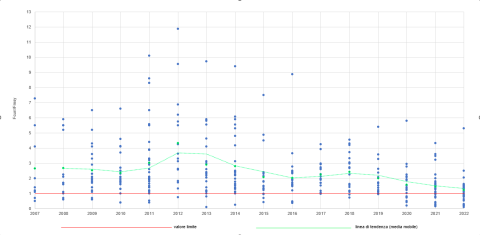
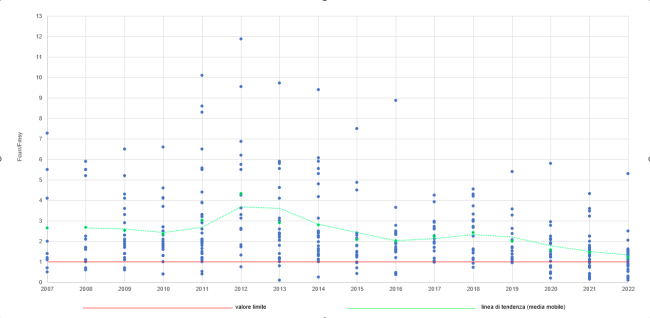
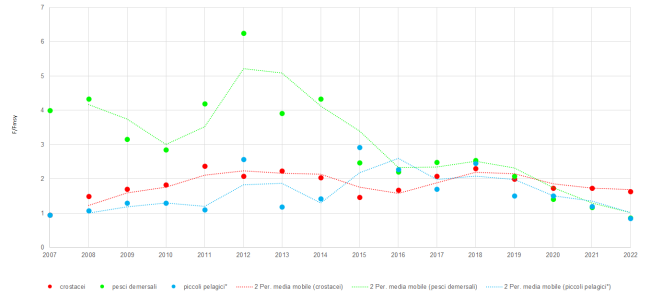
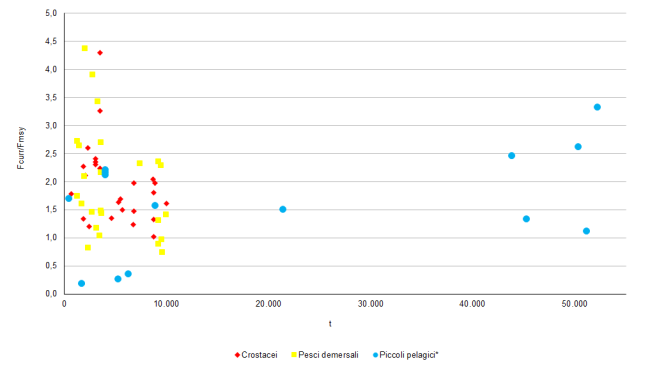
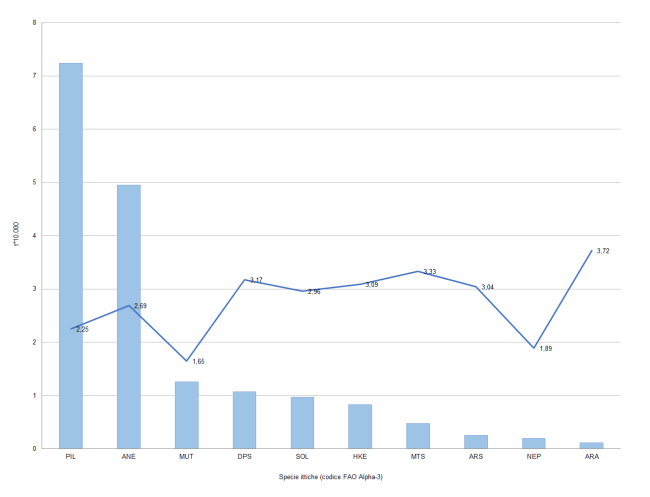
During the 2007-2022 period, most of the examined fish stocks have been in a state of overfishing. Analyzing the annual quantities of landed fish corresponding to the assessed stocks, no correlation is observed between the two values. This is due to the general overexploitation of resources, regardless of the percentage of landings.
The figures present the ratio between the current exploitation rate and the reference value (Fcurr/FMSY) or its proxies as point values, averages, per GSA, or shared stock assessment evaluations. All values above 1 indicate unsustainable exploitation, meaning that the stock is unable to achieve Maximum Sustainable Yield (MSY).
The demersal species group shows a decreasing trend in the average Fcurr/FMSY value compared to crustaceans and small pelagic species (Figure 2), with similar average values among the three groups in recent years (Fcurr/FMSY ratio between 1 and 3).
The Fcurr/FMSY ratio has been assessed in relation to the EU landings of fish species in the Italian GSAs. Figure 3 compares the average Fcurr/FMSY ratio per functional group and GSA assessment (2015-2021 period) with landings in the corresponding GSAs (GSA 9, 10, 11, 16, 17, 18, and 19 - reference year 2018). The graph highlights that "crustaceans" and "demersal fish" generally have lower landing quantities than "pelagic fish."
All groups show a wide range of Fcurr/FMSY ratios, though "crustaceans" and "demersal fish" tend to exhibit higher values. Figure 4 further illustrates that the overall state of overexploitation of major stocks is independent of the number of landings.